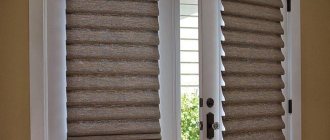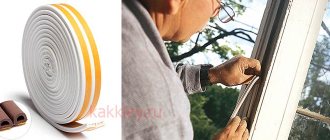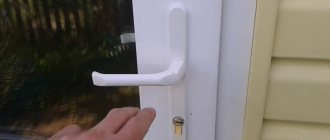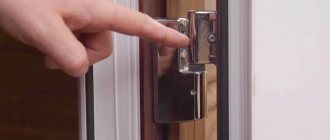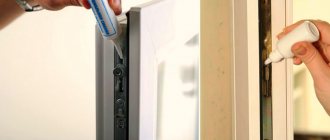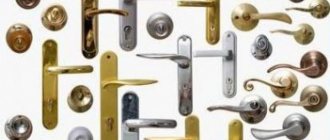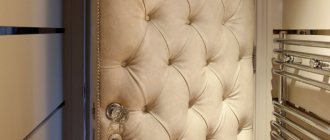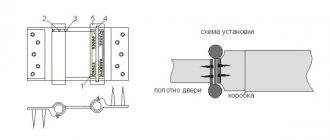A locking latch is an element of door hardware that holds the door in the closed position without additional manipulation of the handle. Most balcony blocks are equipped with such a mechanism by default, so apartment owners do not attach much importance to it, sometimes not even suspecting the existence of the lock. However, if, as a result of natural wear and tear of the fittings, the door leaf no longer locks in the closed position or the builders for some reason did not install a latch for the balcony door, then the issue of its selection and installation becomes relevant.
- Mechanical version
Why do you need a locking latch for a balcony door?
The latch ensures comfortable operation of the balcony block. It is difficult to count the number of daily visits to the balcony, especially if there are smokers in the family. It is inconvenient to use the lock to lock the sash every time. Leaving the balcony open is also wrong - a draft may form or cigarette smoke will enter the room. The latch allows you to close the door from any side by pressing it down a little or pulling it from the outside using a special handle.
For the convenience of closing the sash on the balcony side, a “smoker’s handle” is installed
Another functional purpose of the latch is the correct placement of the sash relative to the frame. The mechanism fixes the door leaf in a strictly defined position, preventing it from sagging.
Note! Even slight sagging of the blade leads to heavier movement of the elements of the locking mechanism and a decrease in its service life.
Depending on the design of the door block, the lock can be built directly into the lock or installed separately. The second option is often found on plastic balcony doors, the design of which does not always include a classic lock with a cylindrical core.
External handle
The handle is a plastic petal.
In order to close, or rather pull, the door from the street side, it is necessary to provide a special external handle. Made of metal, more often of durable plastic, the handle visually resembles a shell or petal in shape. A plastic shell is much more pleasant to the touch, especially in the cold season. But it is easier to break if used carelessly, and the material itself has a tendency to break down under prolonged exposure to sunlight, freezing temperatures and other external factors. The main advantages of a more expensive metal handle are resistance to mechanical loads and a long service life. Typically, the outer door pull handle is located at the same height as the lock's rotary handle. This position for closing the door is very convenient.
You can do without an external shell handle only if the door lock mechanism is double-sided, that is, internal and external rotary handles of the lock are required.
Double-sided handle for a plastic door
The choice of external handles in specialized companies and construction supermarkets allows you to choose a copy with a convenient ergonomic shape and the desired color.
Latch as a door lock element
There are several options for the design of the locking latch, which is built directly into the lock block:
- roller;
- fall;
- magnetic;
- electromechanical.
Roller lock
A latch in the form of a spring-loaded roller is the simplest mechanism for fixing the sash. Such a balcony door lock can be installed either directly in the lock body or mounted separately, since it has no mechanical connection with the door handle.
The mechanism consists of two parts: main and response. The main part, on which the roller is located, is installed on the sash, and the return part is installed on the frame. The principle of operation of the system is very simple: when the door is closed, the roller falls into the recess of the counterpart and is held in this position under the action of a spring. To open the balcony, just slightly pull the handle toward you (or push it away from you) so that the roller disengages.
In some fittings, you can adjust the position of the roller, thereby increasing or decreasing the force of holding the door in the closed position.
>
Roller latch
Hale clamp
The operating principle of a halyard latch for a balcony door is almost identical to a roller latch when it comes to the process of closing the sash. In this case, the spring-loaded crossbar “drops” into the recess of the mating part in the same way, fixing the canvas in the frame. However, because the bolt is beveled, it cannot disengage when moving in the opposite direction, as a roller can.
To open the balcony, you need to use the door handle, which, when pressed, hides the bolt in the body of the lock. This mechanism forces the use of a double handle mounted on both sides of the balcony block. Otherwise, you can only open the door from the side of the room.
Tail latch
Magnetic holder
The built-in magnetic latch on the balcony door is a relatively new solution, which was initially used only in interior structures. In such a mechanism, the crossbar and the counter part are magnets. When the door is closed, the magnets are in close proximity to each other, and the crossbar is attracted to the “return” due to the resulting magnetic field. To return it to its original position and open the balcony, as in the case of the halyard mechanism, you need to press the handle.
In order for magnets to attract, they must have reverse polarity. This must be taken into account when making your own magnetic latch.
>
One of the advantages of magnetic type fasteners is noiselessness, which is claimed by almost every manufacturer. In reality, everything is not so rosy. In many models, magnets have physical contact when triggered, which causes a characteristic click that is quite difficult not to hear.
Magnetic latch
Electromechanical lock
The electromechanical latch for balcony doors is not used as often as other options, due to its high cost and the need to install an additional power supply. The latch is easy to operate and, in addition, serves as a locking element.
The product consists of a mechanical part, which is a regular beveled crossbar, and an electromechanical “response”. It is the latter that is considered the main component of the lock, controlling the locking and unlocking of the sash. The counter part, installed on the frame, is equipped with a movable element, which is driven by an electromagnetic coil. When the bolt enters the “response”, it is blocked and remains in this position until a signal is sent to the coil to unlock the doors.
There are two types of electromechanical latches: normally open and normally closed. In the first case, the lock is in the open state if there is no control voltage on the coil. The second option works exactly the opposite - if there is no voltage, the latch is blocked.
The electromagnet can be controlled by a button, remote control or combination lock. For the balconies of ordinary apartments, such a system may seem too complicated, but in office premises or, for example, in secret facilities with a high level of security, electromechanical latches are not uncommon.
Electric strike with controlled locking
In what cases is it necessary to contact specialists?
Repairing a balcony door with your own hands is not possible in the following cases:
- The profile is cracked. Initially, it is necessary to assess the extent of the damage, and only then make a decision about calling a specialist. If the crack is through or its size exceeds 1 mm, then you should call a specialist (you may even need to replace the balcony door), but if the glazing bead is cracked, then you can cope with its replacement yourself.
- In case of damage to double-glazed windows. Repairing broken window glass on a plastic balcony door with your own hands is impossible due to the fact that in all plastic structures there is air or inert gas inside the double-glazed windows for sealing. For these types of work, it is worth calling a specialist to take measurements of the double-glazed window and submit an application for the manufacture of a similar one.
You can remove a double-glazed window, take measurements and order the same double-glazed window yourself (instructions below), but often such savings do not make sense, firstly, there is a possibility of making an error in the measurements, and secondly, most companies carry out measurement and installation as a gift to purchasing double glazed windows.
- Damage to fittings. The first step is to measure the extent of the damage. For example, you can repair a balcony handle or lock yourself, but only a specialist can repair broken ventilation or alignment mechanism slats from the canopy profile.
Free-fitting latch for plastic doors
Plastic balcony blocks, as a rule, do not have classic locks, and the sash is locked thanks to the presence of multi-locking strip fittings located along the perimeter of the leaf. In such designs, the latch is an independent element and is in no way connected with the operation of the lock and the position of the handle.
There are two types of balcony latches for plastic doors: mechanical and magnetic. Both options are structurally very simple, and their installation does not require serious professional skills.
Mechanical version
The standard configuration of a PVC balcony door usually includes the simplest mechanical latch, the components of which are installed on the leaf and frame. A fixed cylinder is attached to the sash profile, and a metal body with a special groove is attached to the frame profile. There is a spring-loaded element (usually a plate) in the groove, thanks to which the cylinder is held in the closed state and prevents spontaneous opening of the balcony.
The durability of such a retainer is determined by the quality of the spring. In cheap fittings, the spring-loaded element may burst after 1-2 years of active use, causing the roller to no longer be fixed in the groove. Therefore, it is advisable to choose a latch from at least the middle price category.
Standard kit for installing a latch on a balcony
Magnetic version
A more interesting solution is to install a magnetic latch on the balcony door. In this case, a housing with a magnet is mounted on the frame, and a metal plate is attached to the sash profile. The advantage of such a system is its reliability, since there is essentially nothing to break here.
The force of attraction of the door leaf to the frame is determined by the power of the magnet, which may vary depending on the model of the latch.
When the magnetic latch is triggered, a characteristic click is heard, which indicates that the metal plate is attracted to the magnet. For silent closing, a small gap is left between the working and the mating part, but in this case the strength of the magnet must be sufficient to prevent the door from opening, for example, from a draft.
Magnetic latch for PVC door
Possible problems and troubleshooting
With magnetic balcony latches, the question of adjustment does not actually arise. Rather, this applies to locks with a mechanical lock.
The most common cause is a weakening spring located on the back of the roller or ball. In this case, you should unscrew the part of the mechanism in which the rotating element is fixed, pull it out, then remove the spring and try to stretch it slightly.
Then reassemble. If your efforts do not bring the desired result, you should try placing one or more washers of suitable thickness under the spring.
Another problem may occur when, due to sagging or distortion of the door frame, the fixing element no longer fits into the groove of the strike plate. In this case, you should first try to adjust the fastening of the hinges, eliminating the resulting distortion or sagging. If this does not help, you will have to reinstall the fixing bar with the groove.
Rules for installing a latch on a balcony door
Installing a latch on a PVC balcony door is very simple. Below are instructions for installing a mechanical lock, which can also be used for magnetic fittings.
- Open the sash and unscrew one of the screws, which performs the function of fastening the locking hardware.
>
It is advisable to choose a self-tapping screw located as close as possible to the door handle
- Screw the latch cylinder into the resulting hole. The unscrewed screw cannot be used for these purposes. The length of the new fastener must be greater than the height of the cylinder at least.
It is better to tighten the screws with a screwdriver so as not to disturb the threads in the plastic profile
- Close the door and make a mark on the frame opposite the cylinder, according to which to screw the mating part of the latch.
The mark must coincide with the center of the retainer groove
- Close the balcony door and check the operation of the latch.
When installed correctly, the canvas is pressed tightly against the frame, and opening occurs with little effort
Application cases
Door stoppers are small and inexpensive, but very useful accessories. They are used in everyday life, public institutions and industrial premises. Main advantages and reasons for using a retainer:
- ensures safe swinging of the sash, which prevents the doors, furniture and walls themselves from accidental damage;
- fixes the door in a given position in rooms with high traffic or, if necessary, to carry large objects;
- prevents sudden closing of the sash and its possible damage from a gust of wind or draft;
- allows pets to move freely throughout the entire area of the apartment or house;
- allows you to leave children unattended in the room for some time.
Open position clamps, opening angle limiters
Magnetic door lock
A wide category of locks, both in appearance and in the method of fastening and principle of operation. It is useful to have them at home, since situations periodically arise when you need to temporarily lock the door in the open position to carry things in or ventilate. In public spaces with active traffic, such accessories are indispensable.
Another type of magnetic latches
Floor (wall) clamps
Common and easy-to-install types of limiter. They are characterized by ease of installation and use, low cost and long-term reliability. Such devices can be either stationary or portable:
- Mobile. They are placed on the lower part of the sash, open in the desired position, or simply placed under it. They act as a wedge and serve to fix the door in the desired position. The variety of shapes and colors allows you to turn this simple device into an original and stylish interior detail.
- Stationary. They are attached to the floor or wall and prevent the door from opening completely. Made from metal alloys: stainless steel, copper, brass.
- Magnetic (auto-stop). They are a variant of a stationary stop, supplemented by a magnetic plate, which is attached to the door leaf at the same level as the floor fixed part. When the two parts come into contact, the sash is securely fixed in a stable position. A similar magnetic limiter can be attached not only to the floor, but also to the wall.
Over-door clamp STN-0960
The stopper is attached to the bottom of the sash and allows you to temporarily fix the leaf in the open or half-open position. Available in various colors, suitable for installation on wooden, aluminum, plastic doors for any purpose.
